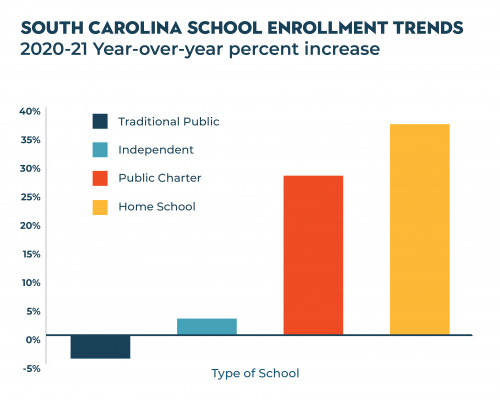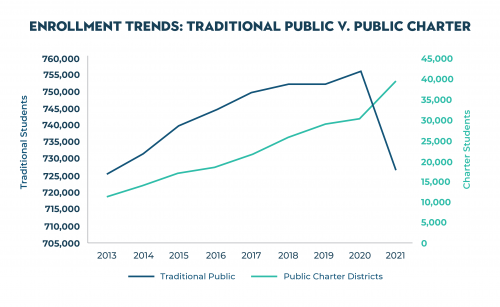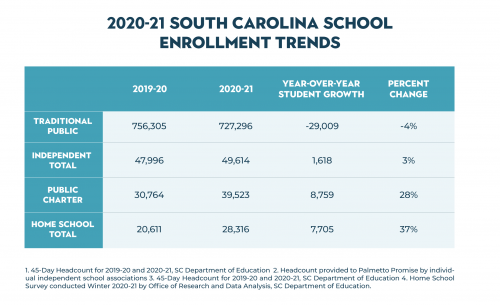Pandemic Parenting: SC Charter, Independent, Home School Options Surge; Public Numbers Down Dramatically
Over the last year, South Carolina’s traditional public school districts have lost nearly 30,000 students according to the most recent student counts released by the SC Department of Education. Where are those students going?
Palmetto Promise collected and analyzed enrollment data across all forms of schooling in South Carolina and found significant increases in options outside of traditional public schools.
Trend 1: Sharp Decline in Traditional Public School Enrollment
With a number of traditional public school districts fully or partially closed to in-person learning throughout 2020, South Carolina parents rapidly sought alternatives for their children. Numbers from the SC Department of Education show a 4% decrease in enrollment across South Carolina’s 79 traditional districts. This translates to a loss of 29,009 students in a single year, a dramatic reversal of years of steady student population growth.
Of the over 700,000 students remaining in traditional public schools, no state attendance data is available to determine how many students have received primarily virtual, paper, hybrid, or in-person learning throughout the year.
Trend 2: Fewer Students, More Funding
As traditional public school district enrollments have declined, they have received what education officials have called an “unprecedented” infusion of new federal cash: around $3.4 billion to be exact. According to the most recent report posted by the SC Department of Administration, as of the end of February, districts have spent around 9% ($315 million) of these funds received through the two CARES Acts and President Biden’s recent American Rescue Plan.
Additionally, SC’s Office of Revenue and Fiscal Affairs (RFA) projects that over $10 billion will be allocated to K-12 schools in regularly recurring federal, state, and local revenue for the 2020-21 school year.
To put those gargantuan numbers in perspective, that breaks down to emergency federal spending of around $4,500 per public school student, in addition to the $14,801 statewide average per-pupil revenue estimates from RFA.
These totals do not include the up to $50 million the General Assembly passed in early March to fund across-the-board teacher cost-of-living raises known as a “step increase.”
Trend 3: Online & Brick and Mortar Public Charter School Enrollment Surges
Overall, South Carolina public charter schools saw a huge jump in enrollment of 28%, or a total of 8,759 students. A key driver of the increase: brick-and-mortar charter schools answered the cries from parents and calls from elected officials to safely deliver face-to-face instruction. Some schools saw their enrollments climb 50% as charter schools hit maximum capacity across the state.
South Carolina’s virtual charter schools also saw a significant spike in enrollment, due to the fact that they had been innovating in the full-time online education space for a number of years. This positioned them perfectly to adapt quickly to the COVID-19 environment, with some virtual schools seeing an over 100% increase in their student enrollment.
Because of the outdated, inequitable way that charter schools are funded in South Carolina, lawmakers recently passed $9 million stop-gap funding measure to help cover the surge in charter enrollment.
Trend 4: Independent and Home Schools Up Significantly
Statewide, the number of students in independent schools increased 4% year-over-year. Anecdotal reports from independent school leaders attribute this increase—in tough economic times—to the fact that they must respect parents as customers and treat them accordingly.
Much like public charter schools, South Carolina independent schools (most of which serve families of moderate income) opened their doors in the fall for 5 day a week face-to-face learning by carefully following the basic health and safety protocols outlined by the CDC. But parents were clearly looking beyond the four walls of a school building for education solutions for their children.
Nearly 8,000 new students began homeschooling this school year, representing a 37% increase in enrollment, the largest of any schooling option. Palmetto Promise reported on the beginning of this trend back in the summer when we first spoke with various accountability groups who work with home school families. At that time, one association reported a 300% increase in inquiries, while others had to place a moratorium on new applications due to the overwhelming demand.
This South Carolina surge in home schooling is further underscored by a recent U.S. Census Bureau survey, which detailed a nationwide increase of 16% in homeschooling between April and October of last year. According to the Census Bureau: “It’s clear that in an unprecedented environment, families are seeking solutions that will reliably meet their health and safety needs, their childcare needs and the learning and socio-emotional needs of their children.”
Emerging Trend: Need for More Flexible Funding
The response to COVID-19’s education disruption has shown that parents, when given the opportunity, will indeed make different decisions for school based on what may be best for their children. For some families, that has meant keeping them in the traditional public school system, while others have looked for innovations that may serve their children better.
Unfortunately, income is too often the major barrier for families whose students may need education alternatives. As South Carolina children struggle to recoup lost pandemic learning, it is vitally important that public policymakers meet parents where they are and find new ways to think about how to support students wherever they learn.









